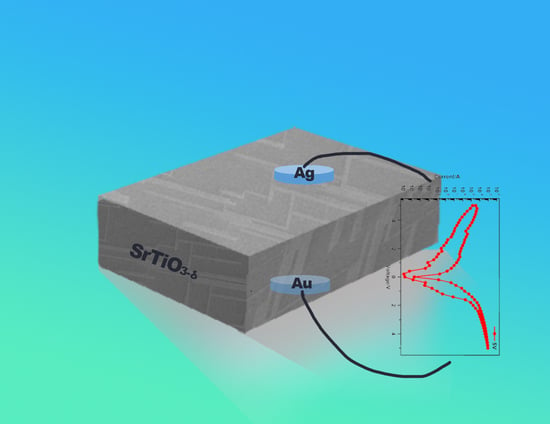Resistance Switching Behavior in Rectangle-Nano-Pattern SrTiO3 Induced by Simple Annealing
Abstract
:1. Introduction
2. Materials and Methods
3. Results and Discussions
4. Conclusions
Author Contributions
Funding
Acknowledgments
Conflicts of Interest
References
- Pan, F.; Gao, S.; Chen, C.; Song, C.; Zeng, F. Recent progress in resistive random access memories: Materials, switching mechanisms, and performance. Mater. Sci. Eng. R Rep. 2014, 83, 1–59. [Google Scholar] [CrossRef]
- Cooper, D.; Baeumer, C.; Bernier, N.; Marchewka, A.; La Torre, C.; Dunin-Borkowski, R.E.; Menzel, S.; Waser, R.; Dittmann, R. Anomalous Resistance Hysteresis in Oxide ReRAM: Oxygen Evolution and Reincorporation Revealed by In Situ TEM. Adv. Mater. 2017, 29, 8. [Google Scholar] [CrossRef]
- Wang, Y.; Shi, X.; Zhao, K.; Xie, G.; Huang, S.; Zhang, L. Controllable resistive switching in Au/Nb:SrTiO3 microscopic Schottky junctions. Appl. Surf. Sci. 2016, 364, 718–725. [Google Scholar] [CrossRef]
- Lee, K.-J.; Wang, L.-W.; Chiang, T.-K.; Wang, Y.-H. Effects of Electrodes on the Switching Behavior of Strontium Titanate Nickelate Resistive Random Access Memory. Materials 2015, 8, 5374. [Google Scholar] [CrossRef]
- Mikheev, E.; Hoskins, B.D.; Strukov, D.B.; Stemmer, S. Resistive switching and its suppression in Pt/Nb:SrTiO3 junctions. Nat. Commun. 2014, 5, 8. [Google Scholar] [CrossRef]
- Rodenbucher, C.; Menzel, S.; Wrana, D.; Gensch, T.; Korte, C.; Krok, F.; Szot, K. Current channeling along extended defects during electroreduction of SrTiO3. Sci. Rep. 2019, 9, 9. [Google Scholar] [CrossRef]
- Schraknepper, H.; Weirich, T.E.; De Souza, R.A. The blocking effect of surface dislocations on oxygen tracer diffusion in SrTiO3. Phys. Chem. Chem. Phys. 2018, 20, 15455–15463. [Google Scholar] [CrossRef]
- Yang, Y.; Lu, W.D. Progress in the Characterizations and Understanding of Conducting Filaments in Resistive Switching Devices. IEEE Trans. Nanotechnol. 2016, 15, 465–472. [Google Scholar] [CrossRef]
- Marrocchelli, D.; Sun, L.; Yildiz, B. Dislocations in SrTiO3: Easy to Reduce but Not so Fast for Oxygen Transport. J. Am. Chem. Soc. 2015, 137, 4735–4748. [Google Scholar] [CrossRef]
- Szot, K.; Speier, W.; Bihlmayer, G.; Waser, R. Switching the electrical resistance of individual dislocations in single-crystalline SrTiO3. Nat. Mater. 2006, 5, 312. [Google Scholar] [CrossRef]
- Celano, U. Filamentary-Based Resistive Switching. In Metrology and Physical Mechanisms in New Generation Ionic Devices; Springer International Publishing: Cham, Switzerland, 2016; pp. 11–45. [Google Scholar]
- Celano, U.; Gastaldi, C.; Govoreanu, B.; Richard, O.; Bender, H.; Goux, L.; Kar, G.S.; Vandervorst, W. Evidences of areal switching in Vacancy-Modulated Conductive Oxide (VMCO) memory. Microelectron. Eng. 2017, 178, 122–124. [Google Scholar] [CrossRef]
- Yang, J.J.; Inoue, I.H.; Mikolajick, T.; Hwang, C.S. Metal oxide memories based on thermochemical and valence change mechanisms. MRS Bull. 2012, 37, 131–137. [Google Scholar] [CrossRef]
- Wojtyniak, M.; Szot, K.; Wrzalik, R.; Rodenbucher, C.; Roth, G.; Waser, R. Electro-degradation and resistive switching of Fe-doped SrTiO3 single crystal. J. Appl. Phys. 2013, 113, 6. [Google Scholar] [CrossRef]
- Wang, Q.; Zhang, W.; Zhang, W.; Zeng, H. In-situ monitor of insulator to metal transition in SrTiO3 by Ar+ irradiation. Appl. Surf. Sci. 2016, 365, 84–87. [Google Scholar] [CrossRef]
- Psiuk, B.; Szade, J.; Szot, K. SrTiO3 surface modification upon low energy Ar+ bombardment studied by XPS. Vacuum 2016, 131, 14–21. [Google Scholar] [CrossRef]
- Patterson, E.A.; Major, M.; Donner, W.; Durst, K.; Webber, K.G.; Rodel, J. Temperature-Dependent Deformation and Dislocation Density in SrTiO3 (001) Single Crystals. J. Am. Ceram. Soc. 2016, 99, 3411–3420. [Google Scholar] [CrossRef]
- Pan, X.Q.; Shuai, Y.; Wu, C.G.; Luo, W.B.; Sun, X.Y.; Yuan, Y.; Zhou, S.Q.; Ou, X.; Zhang, W.L. Resistive switching behavior in single crystal SrTiO3 annealed by laser. Appl. Surf. Sci. 2016, 389, 1104–1107. [Google Scholar] [CrossRef]
- Crespillo, M.L.; Graham, J.T.; Agulló-López, F.; Zhang, Y.; Weber, W.J. Role of oxygen vacancies on light emission mechanisms in SrTiO3 induced by high-energy particles. J. Phys. D Appl. Phys. 2017, 50, 155303. [Google Scholar] [CrossRef]
- Crespillo, M.L.; Graham, J.T.; Agulló-López, F.; Zhang, Y.; Weber, W.J. Isolated oxygen vacancies in strontium titanate shine red: Optical identification of Ti3+ polarons. Appl. Mater. Today 2018, 12, 131–137. [Google Scholar] [CrossRef]
- Crespillo, M.L.; Graham, J.T.; Agulló-López, F.; Zhang, Y.; Weber, W.J. Correlation between Cr3+ Luminescence and Oxygen Vacancy Disorder in Strontium Titanate under MeV Ion Irradiation. J. Phys. Chem. C 2017, 121, 19758–19766. [Google Scholar] [CrossRef]
- Crespillo, M.L.; Graham, J.T.; Agulló-López, F.; Zhang, Y.; Weber, W.J. Recent Advances on Carrier and Exciton Self-Trapping in Strontium Titanate: Understanding the Luminescence Emissions. Crystals 2019, 9, 95. [Google Scholar] [CrossRef]
- Crespillo, M.L.; Graham, J.T.; Agulló-López, F.; Zhang, Y.; Weber, W.J. The blue emission at 2.8 eV in strontium titanate: Evidence for a radiative transition of self-trapped excitons from unbound states. Mater. Res. Lett. 2019, 7, 298–303. [Google Scholar] [CrossRef]
- Eyvazov, A.B.; Inoue, I.H.; Stoliar, P.; Rozenberg, M.J.; Panagopoulos, C. Enhanced and continuous electrostatic carrier doping on the SrTiO3 surface. Sci. Rep. 2013, 3, 1721. [Google Scholar] [CrossRef]
- Szot, K.; Speier, W.; Carius, R.; Zastrow, U.; Beyer, W. Localized Metallic Conductivity and Self-Healing during Thermal Reduction of SrTiO3. Phys. Rev. Lett. 2002, 88, 075508. [Google Scholar] [CrossRef]
- Cuong, D.D.; Lee, B.; Choi, K.M.; Ahn, H.-S.; Han, S.; Lee, J. Oxygen Vacancy Clustering and Electron Localization in Oxygen-Deficient SrTiO3: LDA+U Study. Phys. Rev. Lett. 2007, 98, 115503. [Google Scholar] [CrossRef]
- Shablaev, S.I.; Grachev, A.I. Effect of unsteady-state conduction of a high-resistance SrTiO3 crystal containing a network of conductive nanowires. Phys. Solid State 2016, 58, 1956–1961. [Google Scholar] [CrossRef]
- Liao, X.-X.; Wang, H.-Q.; Zheng, J.-C. Tuning the Structural, Electronic, and Magnetic Properties of Strontium Titanate Through Atomic Design: A Comparison Between Oxygen Vacancies and Nitrogen Doping. J. Am. Ceram. Soc. 2013, 96, 538–543. [Google Scholar] [CrossRef]
- Gautam, S.K.; Das, A.; Ojha, S.; Shukla, D.K.; Phase, D.M.; Singh, F. Electronic structure modification and Fermi level shifting in niobium-doped anatase titanium dioxide thin films: A comparative study of NEXAFS, work function and stiffening of phonons. Phys. Chem. Chem. Phys. 2016, 18, 3618–3627. [Google Scholar] [CrossRef]
- Mi, Y.Y.; Yu, Z.; Wang, S.J.; Gao, X.Y.; Wee, A.T.S.; Ong, C.K.; Huan, C.H.A. Thermal stability of nitrogen-doped SrTiO3 films: Electronic and optical properties studies. J. Appl. Phys. 2007, 101, 063708. [Google Scholar] [CrossRef]
- Soriano, L.; Abbate, M.; Fernandez, A.; GonzalezElipe, A.R.; Sanz, J.M. Chemical analysis of ternary Ti oxides using soft X-ray absorption spectroscopy. Surf. Interface Anal. 1997, 2, 804–808. [Google Scholar] [CrossRef]
- Palina, N.; Annadi, A.; Asmara, T.C.; Diao, C.; Yu, X.; Breese, M.B.H.; Venkatesan, T.; Ariando; Rusydi, A. Electronic defect states at the LaAlO3/SrTiO3 heterointerface revealed by O K-edge X-ray absorption spectroscopy. Phys. Chem. Chem. Phys. 2016, 18, 13844–13851. [Google Scholar] [CrossRef]
- Bailey, T.J.; Jha, R. Understanding Synaptic Mechanisms in SrTiO3 RRAM Devices. IEEE Trans. Electron Devices 2018, 65, 3514–3520. [Google Scholar] [CrossRef]
- Yan, Z.B.; Yau, H.M.; Li, Z.W.; Gao, X.S.; Dai, J.Y.; Liu, J.-M. Self-electroforming and high-performance complementary memristor based on ferroelectric tunnel junctions. Appl. Phys. Lett. 2016, 109, 053506. [Google Scholar] [CrossRef]
- Mojarad, S.A.; Goss, J.P.; Kwa, K.S.K.; Zhou, Z.; Al-Hamadany, R.A.S.; Appleby, D.J.R.; Ponon, N.K.; O’Neill, A. Leakage current asymmetry and resistive switching behavior of SrTiO3. Appl. Phys. Lett. 2012, 101, 173507. [Google Scholar] [CrossRef]
- Chen, X.G.; Ma, X.B.; Yang, Y.B.; Chen, L.P.; Xiong, G.C.; Lian, G.J.; Yang, Y.C.; Yang, J.B. Comprehensive study of the resistance switching in SrTiO3 and Nb-doped SrTiO3. Appl. Phys. Lett. 2011, 98, 122102. [Google Scholar] [CrossRef]
- Adepalli, K.K.; Yang, J.; Maier, J.; Tuller, H.L.; Yildiz, B. Tunable Oxygen Diffusion and Electronic Conduction in SrTiO3 by Dislocation-Induced Space Charge Fields. Adv. Funct. Mater. 2017, 27, 1700243. [Google Scholar] [CrossRef]
- Waldow, S.P.; De Souza, R.A. Computational Study of Oxygen Diffusion along a [100] Dislocations in the Perovskite Oxide SrTiO3. ACS Appl. Mater. Interfaces 2016, 8, 12246–12256. [Google Scholar] [CrossRef]
- Chang, Y.-F.; Fowler, B.; Zhou, F.; Chen, Y.-C.; Lee, J.C. Study of self-compliance behaviors and internal filament characteristics in intrinsic SiOx-based resistive switching memory. Appl. Phys. Lett. 2016, 108, 033504. [Google Scholar] [CrossRef]
- Acharya, S.K.; Nallagatla, R.V.; Togibasa, O.; Lee, B.W.; Liu, C.; Jung, C.U.; Park, B.H.; Park, J.-Y.; Cho, Y.; Kim, D.-W.; et al. Epitaxial Brownmillerite Oxide Thin Films for Reliable Switching Memory. ACS Appl. Mater. Interfaces 2016, 8, 7902–7911. [Google Scholar] [CrossRef]
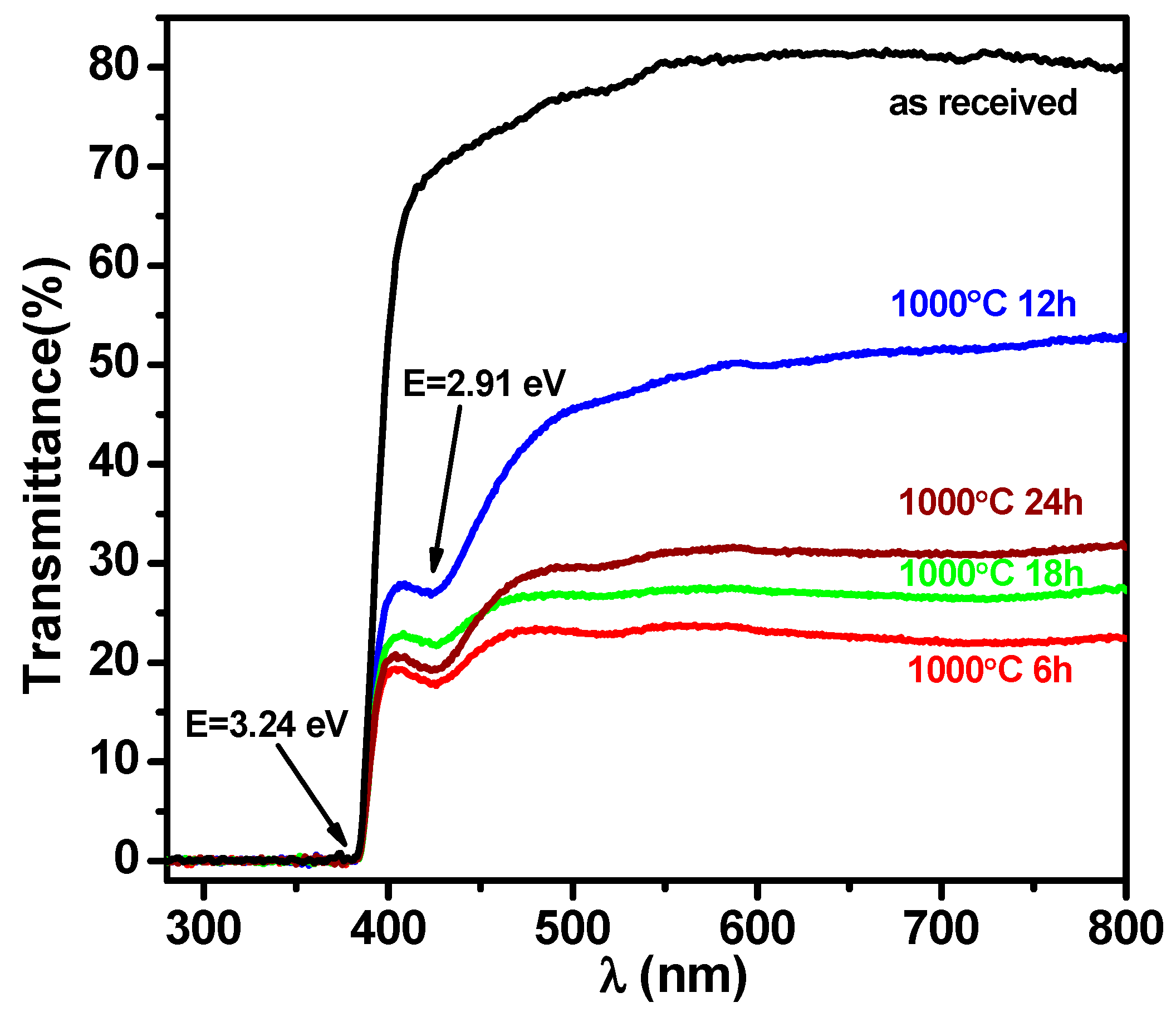
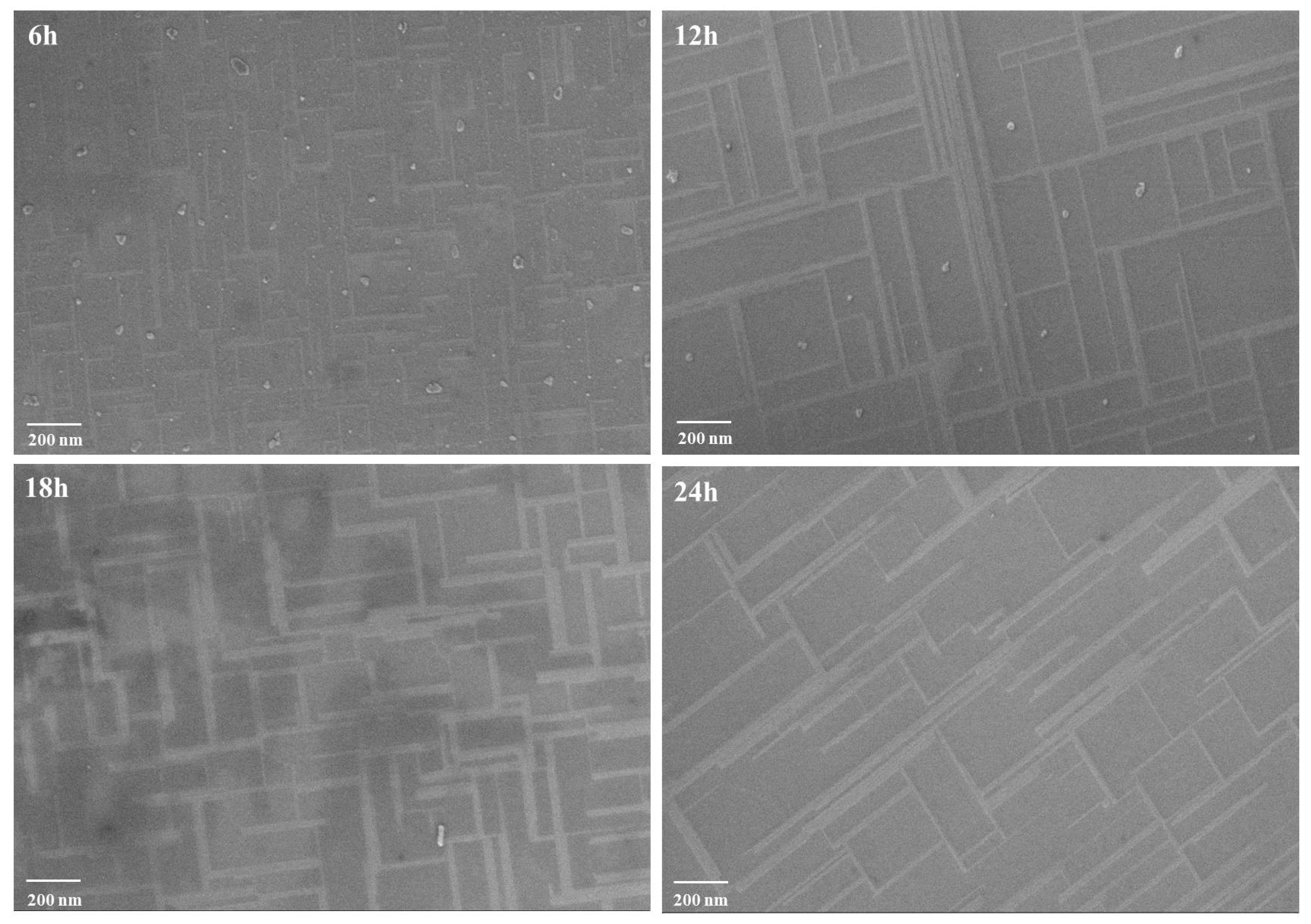
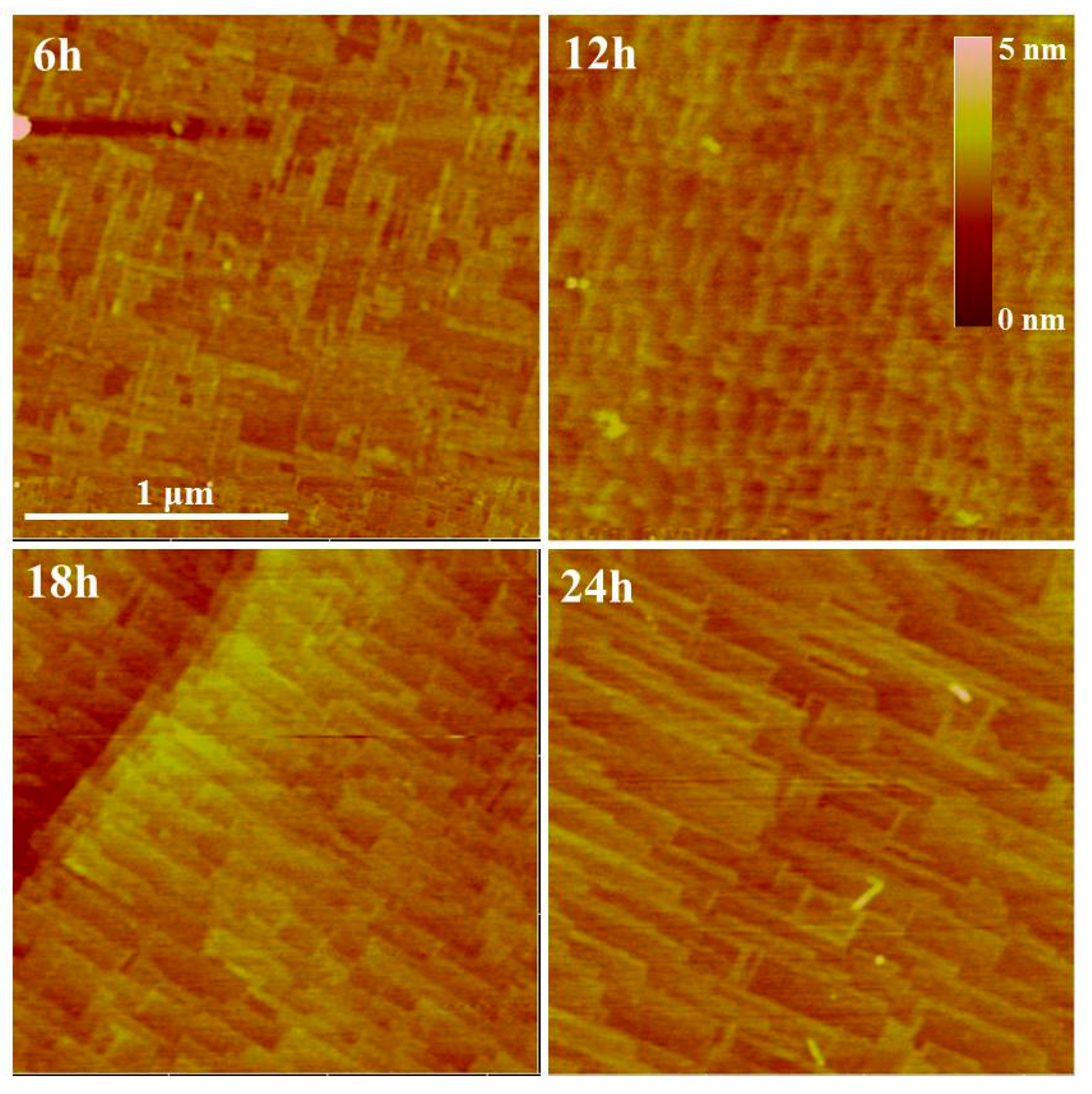
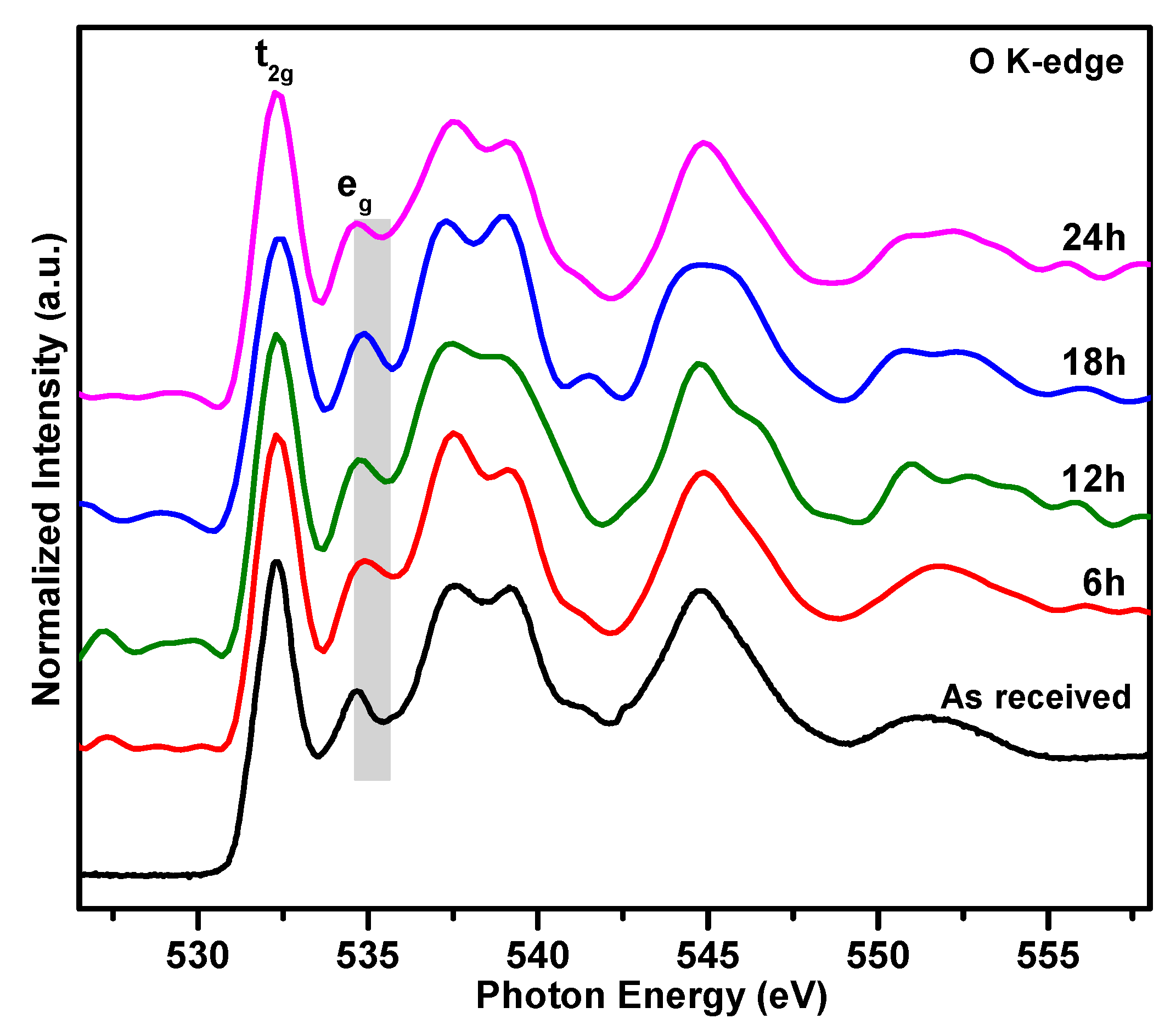
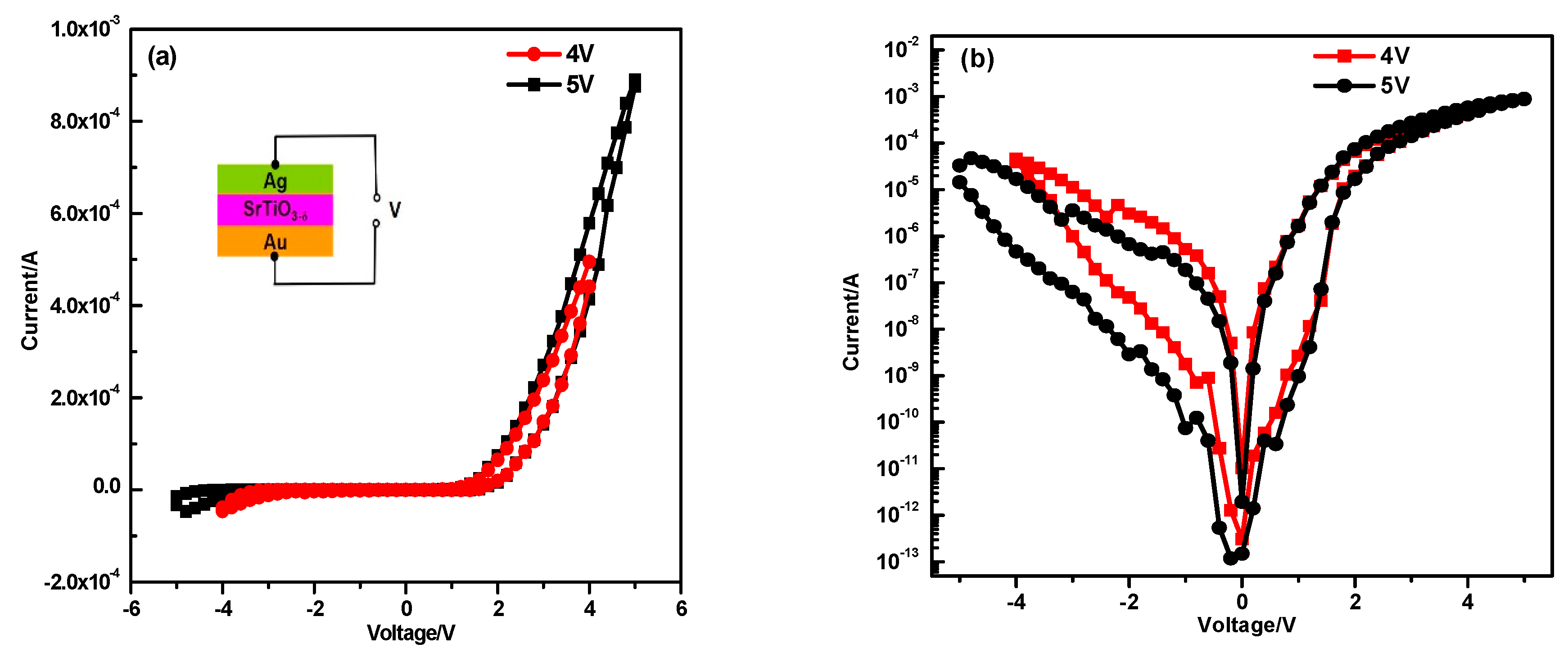
© 2019 by the authors. Licensee MDPI, Basel, Switzerland. This article is an open access article distributed under the terms and conditions of the Creative Commons Attribution (CC BY) license (http://creativecommons.org/licenses/by/4.0/).
Share and Cite
Liao, X.; Zhang, Y.; Wang, J.; Kang, J.; Zhang, J.; Wang, J.; Zheng, J.; Wang, H. Resistance Switching Behavior in Rectangle-Nano-Pattern SrTiO3 Induced by Simple Annealing. Materials 2019, 12, 3698. https://doi.org/10.3390/ma12223698
Liao X, Zhang Y, Wang J, Kang J, Zhang J, Wang J, Zheng J, Wang H. Resistance Switching Behavior in Rectangle-Nano-Pattern SrTiO3 Induced by Simple Annealing. Materials. 2019; 12(22):3698. https://doi.org/10.3390/ma12223698
Chicago/Turabian StyleLiao, Xiaxia, Yufeng Zhang, Jiaou Wang, Junyong Kang, Jinbin Zhang, Jizheng Wang, Jincheng Zheng, and Huiqiong Wang. 2019. "Resistance Switching Behavior in Rectangle-Nano-Pattern SrTiO3 Induced by Simple Annealing" Materials 12, no. 22: 3698. https://doi.org/10.3390/ma12223698
APA StyleLiao, X., Zhang, Y., Wang, J., Kang, J., Zhang, J., Wang, J., Zheng, J., & Wang, H. (2019). Resistance Switching Behavior in Rectangle-Nano-Pattern SrTiO3 Induced by Simple Annealing. Materials, 12(22), 3698. https://doi.org/10.3390/ma12223698





